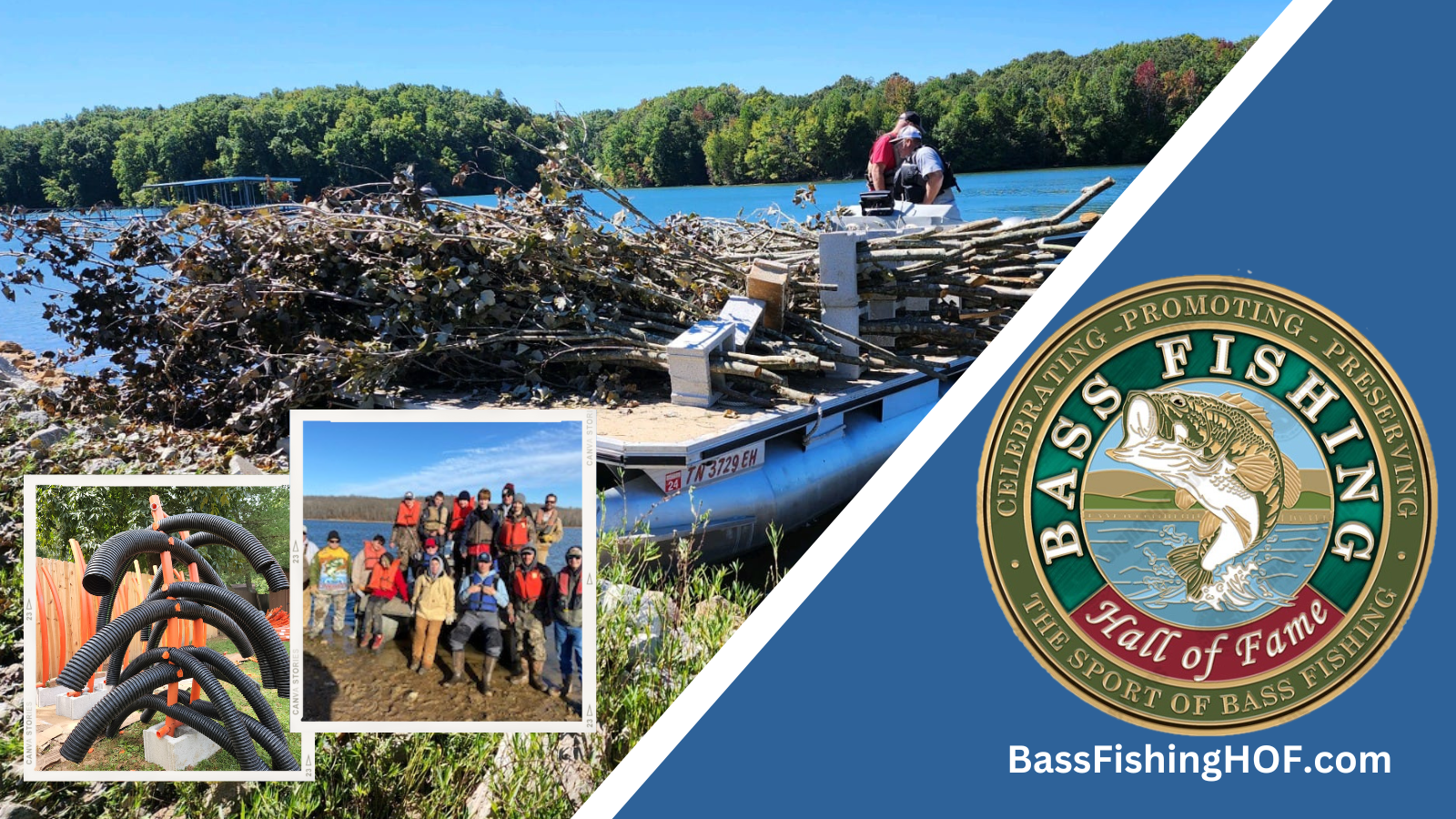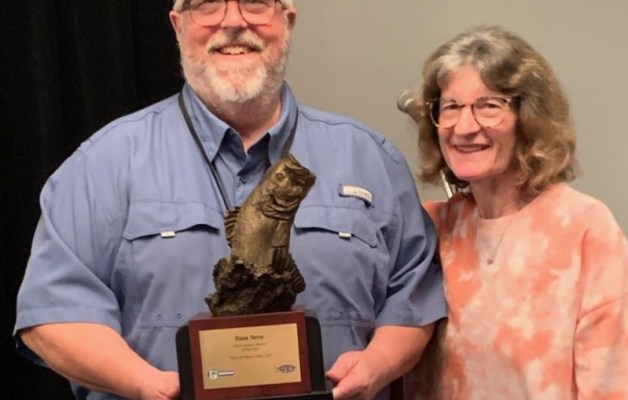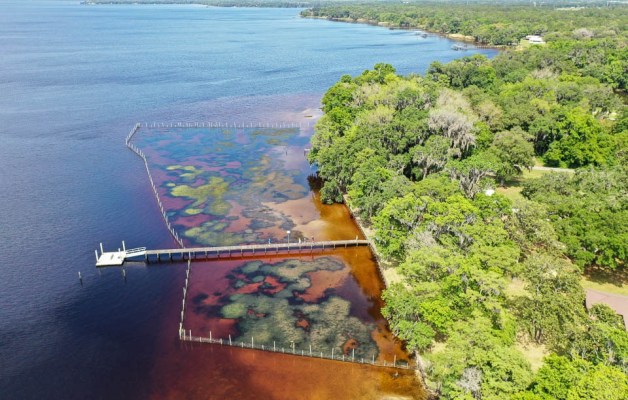
SPRINGFIELD, Mo. – For Immediate Release – June 13, 2023 – As part of its mission to celebrate, promote and preserve the sport of bass fishing, the Bass Fishing Hall of Fame’s Board of Directors is again providing financial support to six major conservation projects that will enhance habitat in lakes in Georgia, Kansas, Kentucky, Tennessee, and Virginia, along with supporting a smallmouth bass tracking study at Lake St. Clair in Michigan.
Over the past four years, the BFHOF’s Board has reached out to local and state bass fishing clubs working with state agencies to provide needed funding for various conservation projects they initiated. “With these new grants, we’ll exceed a total of more than $100,000 in support of fishery enhancement projects, assistance with building live release trailers, and even an information campaign to encourage bass anglers to rid their bass fishing waters in Virginia of invasive species,” said BFHOF conservation committee chair Gene Gilliland. “These bass clubs have ‘boots-on-the-ground’ members who donate their sweat equity on these projects, while the Hall provides financial support for needed equipment, fish-holding underwater structures, and other needed gear to help make the projects a reality.”
The Hall-supported projects include the establishment of shoreline and littoral zone vegetation and installing deep-water fish-attracting structures to improve the overall fish habitat in Clarks Hill Lake, which borders Georgia and South Carolina. The Clarks Hill Youth Fishing Team will be the driving force behind this project, working with Georgia B.A.S.S. Nation and the Georgia Department of Natural Resources. The aquatic plants they will introduce are raised at the DNR’s Aquatic Greenhouse Facility and will provide habitat for not only largemouth bass, but also for other shoreline-spawning species including black crappie, redear sunfish, and bluegill.
Members of the Kansas B.A.S.S. Nation youth program and adult members will work with the Kansas Department of Wildlife & Parks (KDWP) to place both natural and artificial habitat into Wilson Reservoir in north-central Kansas to improve the fishery’s overall health. Cedar trees around Wilson will be selectively harvested, then staged in clusters around the lake to be sunk in conjunction with artificial structures. All of the planted habitat coordinates will be available on the KDWP website so anglers can target the locations.
A mix of youth and adult volunteers from the Kentucky B.A.S.S. Nation, working with the Kentucky Department of Fish and Wildlife Resources will plant up to 675 young cypress trees, a tree native to western Kentucky and one of only a few plant species that can survive along the shoreline and within the drawdown zone of Lake Barkley in order to improve both spawning habitat for bass and sunfish and increase shoreline stability. The sites are being selected by the KDFWR and will focus on mudflats and areas with highly eroded banks, providing needed structure from root systems that will act as shallow water fish habitat when the cypress trees mature.
Bass anglers in Tennessee can look forward to the improvement projects being planned, under the supervision of the Tennessee Wildlife Resources Agency, by anglers from the junior, high school, and college levels associated with the Tennessee B.A.S.S. Nation. Those participating will be educated on and participate in building effective habitat and fish attractor structures, and the benefits of both through proper planning, placement, and evaluation throughout the project. Due to winter drawdowns that can cause significant loss of suitable habitat for both bass and forage fish species, the lakes targeted for the habitat improvement efforts include Normandy and Center Hill Reservoirs.
Lake Gaston, spanning the North Carolina/Virginia border, will benefit from the efforts being spearheaded by the Lawrenceville, Virginia-based Brunswick Academy Fishing Club. Club members will build fish habitat structures and with the advice of aquatic biologists and conservation officers from both states, they will place them in locations in both the North Carolina and Virginia sides of the lake. The structures will provide a sustainable environment to ensure cover against predators and promote healthy feeding and growth for the lake’s bass population.
To help maintain Lake St. Clair as one of the premier smallmouth bass fisheries for both U.S. and Canadian anglers, the BFHOF Board will help fund an acoustic telemetry tracking project to study smallmouth bass movement within the fishery. The data collected will allow Michigan Department of Natural Resources fishery managers to address questions related to the dispersal and movement of bass after being released following tournaments, along with evaluating the survival of fish post-release. The DNR will establish a ‘Class Bass’ program that allows K-12 students to adopt and track the movement of acoustically-tagged fish and learn about the importance of smallmouth bass to the Lake St. Clair ecosystem. They’ve proposed to partner with youth, high school, and college tournaments by providing those anglers with a data collection protocol for fish caught, weighed, and released during their event.
“From the perspective of our Board, the involvement by younger anglers in all of these projects is a great way to promote bass fishing to the next generation, along with ensuring a healthy bass fishery in all the lakes and reservoirs where these projects are taking place,” said BFHOF Board president John Mazurkiewicz. “Along with the efforts of Bass Fishing Hall of Famers Gilliland and Trip Weldon, and Board members Tim Carini, Joe Opager, and Dan Quinn, I wanted to offer my personal thanks for all the time they devoted to the Hall’s conservation grant program. We had 19 different groups applying for our grants so there was a good amount of work to do in evaluating the most needed projects. It’s a big win for the sport of bass fishing.”
Gilliland notes that in addition to the grant program, the BFHOF Board members look for other opportunities to financially support fishing organizations that have projects that mirror the Board’s mission. This has previously included assistance to groups including the Mille Lacs Smallmouth Alliance, Fishing’s Future, Friends of Reservoirs, the IKE Foundation, the South Carolina Wildlife Federation’s college angling recruitment program, and the Florida Wildlife Commission’s school fishing club program.




